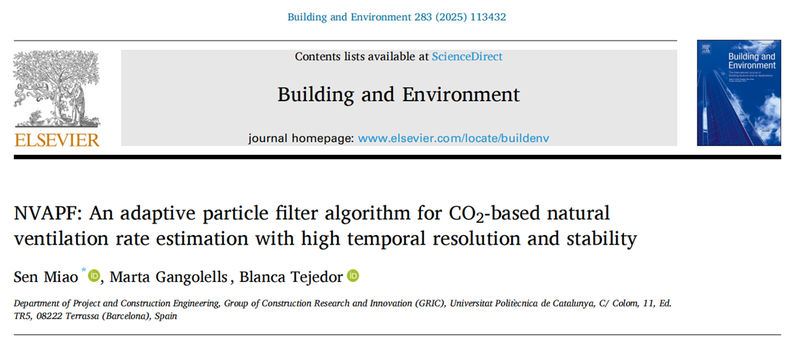The IAQ4EDU project has developed a novel algorithm with software for natural ventilation rate calculation
Jul 18, 2025
The article has been published in the journal Building and Environment
The IAQ4EDU project has developed a novel algorithm with software for natural ventilation rate calculation. This software can be used for estimating ventilation rate in naturally ventilated buildings, while the the estimation stability has been improved by 6 times than the existing common approach. The article has been now published in the top-indexed journal Building and Environment (JCR-Q1, Impact Factor: 7.6), is entitled "NVAPF: An adaptive particle filter algorithm for CO2-based natural ventilation rate estimation with high temporal resolution and stability". Dr. Sen Miao conducted this research during his doctoral thesis research, under the supervision of Prof. Marta Gangolells, principal investigator of the IAQ4EDU project, and Prof. Blanca Tejedor.
CO2-based ventilation rate estimation techniques have been widely used in relevant studies in naturally ventilated educational buildings. This research proposed an adaptive particle filter algorithm for CO2-based natural ventilation rate estimation and validated it through a case study in an educational building. Compared with the existing transient mass balance model and the extended Kalman filter technique, the estimation stability has been improved by nearly 6 times and 3 times, respectively. More importantly, the proposed algorithm is significantly more robust to abrupt changes in indoor CO2 and can effectively avoid large drifts in the estimated ventilation rate due to sudden window opening and sudden changes in room occupancy, demonstrating great practical applicability for real-time estimation with a high temporal resolution of 1 minute. To help relevant users with practical applications and analyzed the impact of simplification strategies commonly used in relevant field studies, while an open, user-friendly software has been developed for relevant users for a convenient implementation.

Execution process of the developed software
All details in the online version of the article: https://doi.org/10.1016/j.buildenv.2025.113432
For more information visit our social media pages:
 LinkedIn of the project
LinkedIn of the project  GRIC's Twitter
GRIC's Twitter  ResearchGate
ResearchGate


Share: